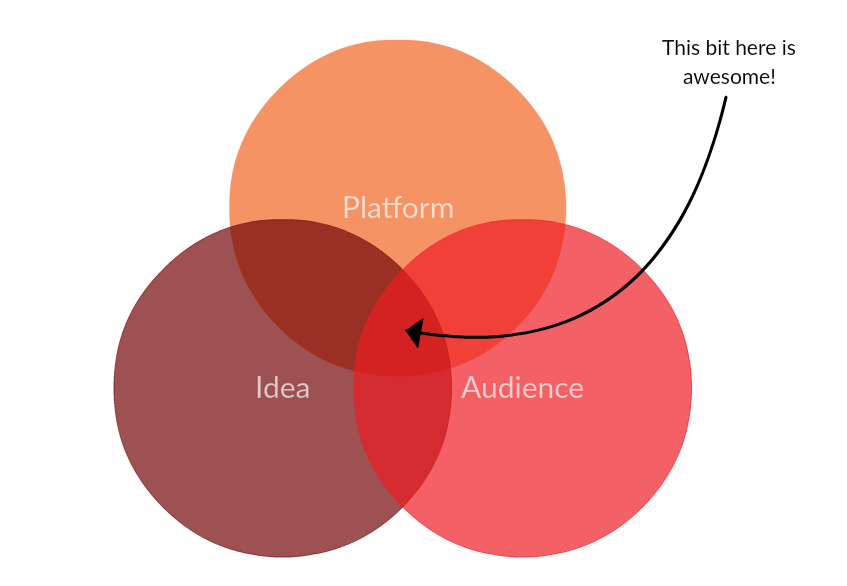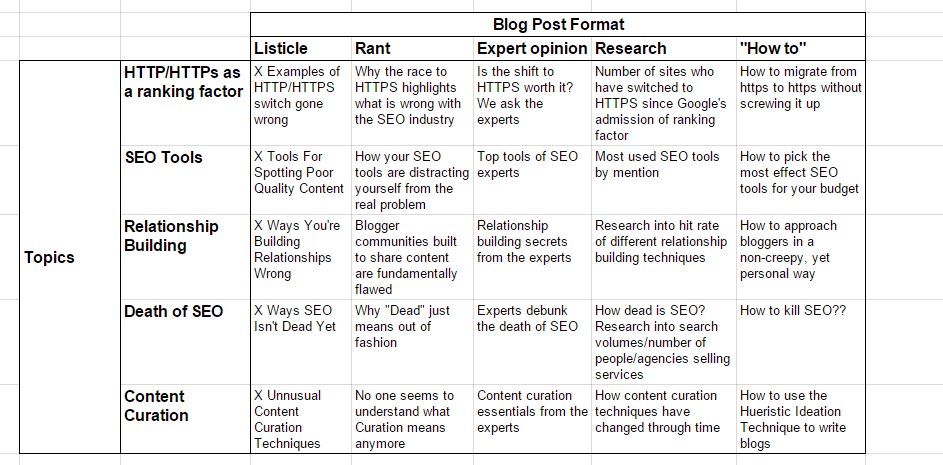Content has never gone out of fashion, it has always been important to us for one reason or another (maybe with the exception of a few years within the SEO industry!). Content needs three things, distribution, an audience and perhaps most importantly, the idea which it rests on.

Getting the platform right is quite possibly the easiest part of the process – at least it ought to be! There are so many platforms that you can publish to and relative novices can get the fundamentals which are needed with an inquisitive mind, Google and some patience.
Audience and the Idea, however, can be more troublesome for different reasons. Whilst I won’t linger on Audience too heavily the safe assumption here is that you know who you want to consume the content – that is a halfway decent start. This leaves us with the Idea, we’ve all had one (if not more), having one good idea and getting a workable idea for multiple blogs over a period of time are two completely different things!
There are hundreds of blogs out there which give some good advice as to how to foster this process of searching for ideas, capturing when they come and recalling them when they’re needed, all essential processes for many, no doubt there. What these guides miss though, is the concession that the need to be innovative consistently is hard, but we need this to be more repeatable!
The Heuristic Ideation Technique
Spurred on largely by Kelvin Newman’s BrightonSEO presentation, and in search of another way around this problem I’ve recently gone back to Ideation and in particularly the Heuristic Ideation Technique (HIT). Roughly speaking HIT means developing ideas by mixing stuff and seeing what happens, but to anyone who asks who wants a more impressive answer it’s a highly skilled way to generate innovative ideas by iterating on existing ones in unexpected ways.
Whilst I don’t want to linger too heavily on the theory behind the process, the fundamentals lie in taking traits from two things/ideas/concepts and intersect them with each other. This produces a matrix of content ideas which you can then map out into an editorial calendar or continue to iterate on for something bigger.
For those who want to read into this further the following example from Gamestorming (again, thanks Kelvin) is a good place to get some further insights.
In my experience the hardest part of HIT is actually in defining the two attributes (traits) that the matrix will be built on. In the below example (again, from Gamestorming), toys and the type of play the toy will promote are the two sets.

Some ideas just won’t work (Simulation puzzles??) and racing instruments, for example don’t go anywhere, however, there are a handful of ideas that you almost-certainly wouldn’t have come up with had you not been comparing seemingly incompatible traits (I’d be all over a buildable instrument).
How Can HIT Work for Content Planning?
How does this help us develop content ideas though? One method, borrowing from DR Nathan Ryder, sees us using broad blog topics as one set of attributes pitted against types of blogs as the other.
Blog Format – these are just a handful of blog types that can all be pretty successful
- Research
- “How to”
- Expert Opinion/ Ego bait
- Listicle
- Rant
Topics – I used SEO as the base here and scouted out Buzzsumo and Inbound.org to get a feel what was “on trend”
- Shift from HTTP to HTTPs as a ranking factor
- SEO Tools
- Relationship Building
- the “Death of SEO”
- Content curation
With these in mind, it’s time to create the grid and fill in the blanks – I’ve made this on a spreadsheet and brainstormed by myself, but this works equally as well (if not better) with a wall, some colleagues and a pack of post-it notes.

Looking through the grid, it’s clear that not every idea there is going to be a winner, yet the Rant and Research columns have yielded some ideas I’d want to explore further. What ideas you run with will ultimately depend on the time/budget/purpose of the blog. For example anything research related will involve some extra effort whereas a rant will be easy to write if you know what is controversial and can pitch it at the right level.
This way may seem lacking in imagination, we have two lists of familiar attributes and we’re just combining them, it almost feels too easy. But the real secret of this method is that the prospect of finding “New ideas” is a bit of a falsehood. Really, what innovation is is a combination of existing ideas that aren’t thought of as being mixable – think of it like this, “chalk and cheese is more interesting than chalk and limestone“.
HIT with Audience in Mind
An important step to move on with from here is to think more of who is going to be interested in the content afterwards (i.e. Audience in the venn above), we can make things easier for ourselves by instead approaching the initial stages slightly differently. When defining our set of traits, we can base this much more strongly around a particular trend/website/person.
For example run through a twitter feed to pick out the key traits of items shared on their profile, or run a website’s RSS feed through a wordcloud generator to identify the key things they post about. With this list you have your topics that’ll appeal (are most posted), then put their website through a tool like BuzzSumo or Socialcrawlytics to see what types of post are most popular.
The following is the StrategiQ blog ran through an HTML5 wordcloud generator, if you’re unfamiliar with a blog and the types of content that they post, this’ll get you in the picture pretty quickly!

With this targeted data you know that the HIT matrix you produce is going to be built on topics that website/influencer loves to share and write about in a format which most likely fits what they do already. The beauty here is that when you pitch them something, no matter how strange or unexpected the idea, it’ll be in their comfort zone – making outreach easier.
A word of caution, the whole point of this ideation process is to create something that is new and unexpected – loading the dice too heavily in favor of familiarity for your outreach target may kill the very process you’re attempting to foster. It’s going to be a balance which will shift from project to project, but just be weary of it!
This is only just scratching the surface of the ideation process, as you combine different sets of traits you’ll see greater combinations of ideas and hopefully find something awesome in the process.


















